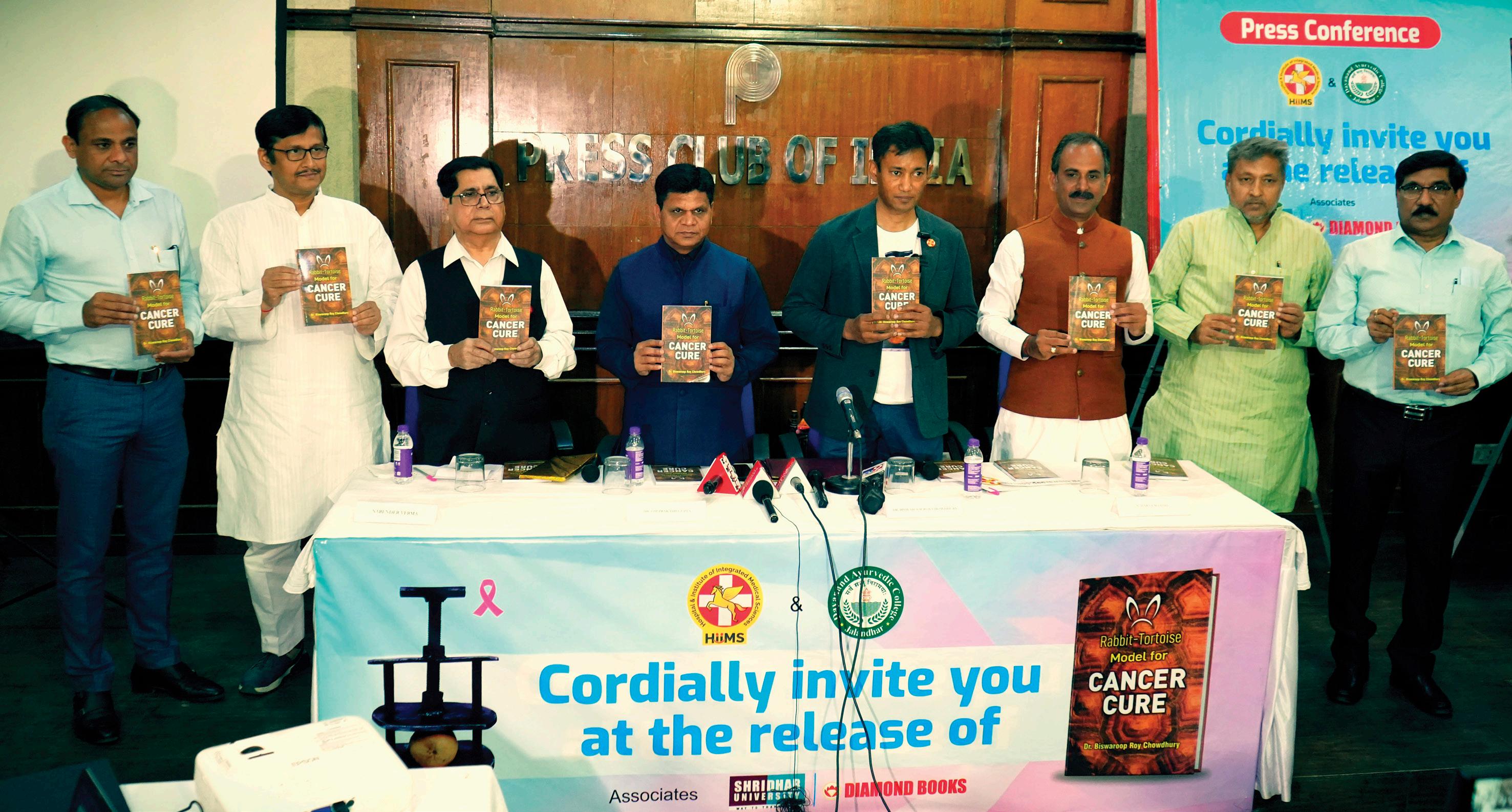The Cancer Cure Handbook That Will Change Your Life Forever
In a world where cancers continue to rise, cancer detection and treatments are becoming increasingly expensive, troublesome, and opaque. Dr. Biswaroop Roy Chowdhury’s probing, investigative, and solution-focused book, titled Rabbit-Tortoise Model for Cancer Cure, attempts to clear the air about cancer, once and for all. It promises to serve as an eye-opener in a world where Big Pharma is having the last say.

to Page
Bitter Pill To Swallow: India’s Sharp Medicine Price Hike

Read on Page 04

Don’t Create Frankenstein’s Monster: Open Letter Warns A.I. Empires




Read on Page 05
Sudden Deaths, Covid Jabs: Investigative Book Connects The Dots Read on Page 10
25/-
Rs.
07
2)
@EmpireDiaries Read on Page
(Turn
Chief Editor: Dr. Biswaroop Roy Chowdhury
Why Pentagon Is Still The World’s Biggest Military Force
Chugalkhor Sourced from www.empirediaries.com Year 1 Issue 6 Delhi (NCR) April 15, 2023 (Fortnightly)
This Book Will Change The Way You Look At Cancer
Dr. Biswaroop Roy Chowdhury’s against-the-tide work, titled Rabbit-Tortoise Model for Cancer Cure, promises to serve as an eye-opener in a world that is charmed by Big Pharma.
A Special Report
April 15, 2023:
In a world where the corporate medical industry wants people to believe it’s on a mission to make the planet a safer place, it’s a paradox that cancer deaths are now at an all-time high in 12,000 years of human civilisation – both in India and abroad.
According to the latest available data on reported cancer deaths, it was the second biggest killer globally after cardiovascular diseases in 2019. In fact, every sixth death in the world today is due to cancer, as revealed by the IHME (Institute for Health Metrics and Evaluation).
In 2019, India witnessed 932,587 reported cancer deaths – making it the country’s third-biggest
killer after heart-related diseases and respiratory ailments. Globally during the same year, cancer was the second-largest killer after cardiovascular fatalities, claiming 10.08 million lives.
It is in these dystopian times that a timely and relevant book has come out, authored by Dr. Biswaroop Roy Chowdhury, which demystifies how the mainstream, commercialised cancer industry functions, and also how cancer-hit and cancerprone people can wriggle out of Big Pharma’s clutches via cheap, indigenous prevention techniques and treatments.

Dr. Roy Chowdhury is a widely consulted medical doctor who spent his lifetime theorising and devising ways to cure pressing health issues, such
as cancer, diabetes, high blood pressure, thyroid problems, critical kidney-related ailments, and even Covid-19, using tried-and-tested naturopathy and dietary treatments.
In his rabble-rousing book titled Rabbit-Tortoise Model for Cancer Cure, the doctor who is based out of north India and is attached to multiple hospitals, chalks out simple ways and steps to tackle the escalating cancer crisis.
According to Dr. Roy Chowdhury’s outline, the people first need to know that all of us have detectable “indolent” cancer cells, or dormant cancer cells, in our bodies. Secondly, he points out that the mainstream practice of biopsy and other diagnostic tests are overrated because they
“cannot distinguish between indolent cancer cells and aggressive cancer cells” in the body.
Thirdly and crucially, he argues that once the standard corporate medical industry drills – biopsy, radiation therapy, chemotherapy, and surgery – are conducted on the patients, the chances of indolent cancer cells transforming into aggressive cancer cells goes up.
As a tried-and-tested solution to reversing critical-state cancer, the medical practitioner writes with conviction that fixing the human body’s natural body clock, called the ‘circadian cycle’, can dial down aggressive cancer cells back to indolent or dormant status.
Chugalkhor Times Delhi (NCR), April 15, 2023 | Year 1 • Issue 6 02
Dr. Biswaroop Roy Chowdhury (4th from right) at the launch of his rabble-rousing book on cancer cure at Press Club of India in New Delhi on April 13, 2023.
TORTOISE VS. RABBIT
“In the Rabbit-Tortoise model, ‘tortoise’ represents an indolent cancer cell, which sits silently in your body throughout your life without harming you, and ‘rabbit’ represents an aggressive cancer cell, which jumps from one organ in the body to another and has a potential to cause harm,” writes Dr. Roy Chowdhury in his book, which was launched at Press Club of India in New Delhi on Thursday.
He was joined at the media interaction by veterans from India’s naturopathy circles and supporters of indigenous medicine, including HIIMS Hospitals founder Acharya Manish, Dr. OP Gupta, and Narender Verma, among others.
Readers can access the soft copy of the entire book on the website Biswaroop.com and can watch the launch event on the website coronakaal.tv.




Dr. Roy Chowdhury was scathing in his criticism of the corporate medical industry that pushes exorbitant cancer detection and treatments, especially mammography, biopsy, and chemotherapy. “Mammogram tests are evidently more harmful than they are useful because of their faulty detection process in which needless pressure is applied on the breasts,” he warned at the press event. He labelled the widely used breast cancer detection system as not just a painful experience for patients, but also as a procedure that can aggravate the cancer.
On biopsies as a popular cancer detection mechanism, he pointed out, “It’s definitely not a procedure I would recommend to any person suspected of having cancer. What really happens during a biopsy? A portion of the body’s suspected cancerous part is clipped out, which in turn, not only gives the patient a lot of pain, but can even aggravate the cancer in many cases.”
The doctor, who travels around India and abroad delivering talks on prioritising cheaper, indigenous therapies for lifestyle diseases over costly corporate medication and treatments, was equally critical of chemotherapy.
“I would strongly recommend people detected to have cancer to completely avoid chemotherapy as I consider the procedure as poisonous for the body, let alone being helpful,” Dr. Roy Chowdhury asserted.


In his inimitable style, the doctor demonstrated to the audience how mammography can have a negative impact on the human breasts, and also how people can avoid the prospect of cancer altogether by fixing their body clock.
JALLIANWALA BAGH COMPARISON
Recalling a slice of India’s dark, colonial history as he took a swipe at profit-hungry Big Pharma,
Dr. Roy Chowdhury said, “We chose today, April 13, for this book launch in order to draw parallels with the Jallianwala Bagh massacre, which happened on this day back in 1919. We all hold the British colonisers at that time responsible for the massacre of innocent protesters in the standoff in Amritsar. But if you think deeply, the Britishers didn’t fire the shots. It’s the Indians in khaki uniforms who carried out their bosses’ orders and opened fire on innocent Indians.”
“The khakis of 1919 are the white coats of today,” he said, lamenting that India’s mainstream doctors are knowingly or unsuspectingly thrusting upon helpless Indians the profiteering medical tactics of cancer detection and treatment that actually originated in faraway foreign lands.
Whether one agrees or not with what’s written in Rabbit-Tortoise Model for Cancer Cure, the 119-page book promises a lot as it comes loaded with testimonials of cancer patients cured by naturopathic treatments, and numerous worthwhile references.
Delhi (NCR), April 15, 2023 | Year 1 • Issue 6 Chugalkhor Times 03
Credit: Pixabay Extraordinary Feats... ...Extraordinary People For making or breaking a record go to www.indiabookofrecords.in/apply B -121, 2nd oor, Green Field Colony, Faridabad-121010 (HR) Mob.: +91-9999436779, E-mail: ibr@indiabookofrecords.in Website: www.indiabookofrecords.in
Credit: Pixabay
Credit: Pixabay
Bitter Pill To Swallow: India’s Sharp Medicine Price Hike
The prices of essential medicines in India have gone up starting this month by a huge margin. What does it mean for pharma empires?
What does it mean for the masses?
—A Special Report
April 15, 2023:
In what could be a bitter pill to swallow for the average Indian who is struggling to negotiate inflation, joblessness, and inequality, the country’s healthcare officials have paved the way for an unprecedented wealth transfer from the hands of the helpless masses to the coffers of Big Pharma giants.
Starting April 1, foreign and domestic drugmakers operating in India got the government’s nod to hike the prices of essential medicines by well more than 11%. The escalation in prices covers basic medicines, such as painkillers and antibiotics, and also those for treating life-long conditions, such as diabetes, chronic infections, high blood pressure, and cardiac problems.
On March 25, the Indian government announced that pharma companies had been allowed to sharply increase drug prices, arguing that it’s unavoidable as the rates are linked to a rise in India’s WPI (Wholesale Price Index).

This is the highest price rise of essential drugs since the new WPI-linked system was introduced, affecting a large number of patients, particularly those battling urban lifestyle diseases.
BIGGEST PRODUCER OF GENERIC DRUGS
Incidentally, India makes 62% of all vaccines used globally, and is the largest producer of the world’s generic drugs – cheaper pharmaceutical products made to match brand-name drugs in quality and performance as well as safety.
A quick look at the prevalence of three maladies – cardiac issues, hypertension and diabetes –reveals the guaranteed higher profits set to flow into the coffers of pharma companies driving the Indian healthcare sector, which was worth $280 billion in 2020 and estimated to reach $372 billion by 2022.
India is known as the world’s diabetes capital, with the lifelong condition likely to affect seven
crore people – more than Britain’s entire population – by 2025, and over eight crore people by 2030.
According to the WHO (World Health Organisation), around 35.4 lakh deaths occur in India annually due to cardiovascular disease. Indians also have the highest rate of coronary artery disease. When it comes to high blood pressure, an estimated 22 crore Indians – close to the population of Nigeria – have the problem.
The decision will have wide ramifications in the poverty-torn country, covering 384 drugs and over 1,000 formulations that fall under the category of essential medicines, as prescribed by the WHO. The world body says essential drugs or medicines are those “that satisfy the healthcare needs of a majority of the population; they should, therefore, be available at all times in adequate amounts and in appropriate dosage forms, at a price the community can afford”.
Launched in 1977, the Essential Medicine Concept constitutes one of the eight pillars of the
WHO’s “primary health care” strategy. The WHO has adopted a flexible approach with regard to the specific medicines to come under the category in a particular country, and entrusted the national authorities to make the decisions.
Consequently, in India, the government has published what is called the NLEM, or the National List of Essential Medicines.
In the Indian scenario, the government’s announcement of the hike in the ruse of WPI increase goes against the spirit of the last part of the WHO’s definition of ‘essential drugs’ – “at a price the community can afford”.
Two points are worth exploring here. Firstly, last year, too, the government had declared a WPI-linked hike of 10.7%. But several drug manufacturers pegged the raise at less than 5%. This was apparently done because of market forces; in other words, to ensure competitors did not run away with orders by offering medicines at lower prices.
In a free-market economy, no manufacturer would want to sell his goodies at a loss. The fact that some drug makers went for a smaller hike is a fair indication that the price was enough to make a decent profit. To buttress this argument, one can take a look at the profit margins of the leading pharmaceutical companies.
Cipla was the leading pharma company in India as of July 2022 with a net profit of about Rs 3,000 crore. Divis Labs and Glenmark came second and third with net profits of around Rs 2,900 crore and Rs 2,000 crore, respectively, during the same time period.
Also, a price war ensues only when the selling price is competitive, or when it is above the profit line. This shows that the price fixed by the government is clearly on the higher side. It also
Chugalkhor Times Delhi (NCR), April 15, 2023 | Year 1 • Issue 6 04 Credit: Pixabay
(Turn to Page 09)
Don’t Create Frankenstein’s Monster: Open Letter Warns A.I. Empires
April 15, 2023
In the early years of the 20th century, when technological advancement was picking up pace, English author Aldous Huxley picturised a dystopian society in his landmark 1932 book Brave New World. The novel’s storyline delivered a prophetic warning to a world getting increasingly charmed by technological progress.
Huxley’s cryptic message was disturbing –by nurturing genetic technology, the species Homo Sapiens might someday end up creating a monstrous superhuman.
Since the book hit the stands, 91 years have elapsed. From genetic technology to AI (artificial intelligence), it has been a long and complicated journey for science and technology. But the warnings given by the writer-philosopher now seem to be resonating louder than ever before, with a large and influential section of the global science, tech, and academics community calling for an immediate end to modern-day Big Tech empires’ imperialist overreach.
With AI technology growing from strength to strength at breakneck speed, an open letter has been signed and shot off by top names across tech and cultural circles, calling for an immediate
suspension of all major AI experiments for at least six months.
The public letter came in the backdrop of the development of GPT-4, the latest updated version of ChatGPT, an AI-based chatbot. It’s computer programme that allows humans to interact with digital devices as if they were communicating with a real person.
Launched on November 30, 2022 by San Francisco startup OpenAI, in which tech giant Microsoft has made huge investments, the chatbot reached 100 million monthly active users within two months. The revolutionary feature of ChatGPT is that it is trained to learn what humans essentially mean when they ask a question.
SUPERHUMAN POWERS
Less than four and half months into its existence, ChatGPT has become a global talking point, with media analysts, technological experts, and nextdoor neighbours calling it a game-changer for its bewildering capabilities. The awestruck world’s fixation with what has been described as the latest technological marvel hit a further high with
the launch of ChatGPT’s latest variant, GPT-4, on March 14.
In a research paper on an early version of GPT4, Cornell University scientists noted that the AI chatbot has been trained using an unprecedented scale of computing and data. They said that “beyond its mastery of language, GPT-4 can solve novel and difficult tasks that span mathematics, coding, vision, medicine, law, psychology, and more, without needing any special prompting.
“Moreover, in all of these tasks, GPT-4’s performance is strikingly close to human-level performance, and often vastly surpasses prior models such as ChatGPT,” the researchers noted.

On the flip side, ChatGPT has come under growing criticism for its potential to take over many human tasks, which may have disastrous consequences for the working class. For example, educationists have claimed that since students now have ChatGPT at their disposal, schools would think twice before giving homework. There are
fears that ChatGPT could take away millions of white-collar jobs in at least 10 sectors.
However, as Empire Diaries recently pointed out in a special report, it’s technically wrong to blame ChatGPT itself for sparking sackings. To put it in a reductionist way, ChatGPT is just a lifeless technology that itself can’t sack anybody. Such decisions are, and would be taken, by ruthless corporate tzars, who use tech tools such as ChatGPT as convenient excuses to fire employees.
GPT-4 has also been drawing flak across the world for peddling misinformation and toxic content, which OpenAI admitted in its own technical report. The Silicon Valley company revealed that the prototype or early version of GPT-4, when prompted by user queries, could suggest users how to kill people, practise antisemitism, and even issue gangrape threats. OpenAI assured that such behaviour of the technology was corrected in the version launched for mass use.
(Turn to Page 09)
Delhi (NCR), April 15, 2023 | Year 1 • Issue 6 Chugalkhor Times 05
Credit: Pixabay
As ChatGPT and its newer editions are becoming bigger and bigger, a petition signed by Elon Musk, Yuval Noah Harari, etc. calls on Big Tech companies to immediately halt Artificial Intelligence experiments and review their impact on society.
—A Special Report
Kashmir Files: Will The Lithium Discovery Be A Game-Changer?


of southern India’s Karnataka state were also classified in the “inferred category”.
“This is a preliminary estimate and requires further exploration efforts to convert the estimated resources to an exploitable category with a high degree of confidence level and explore the possibility of augmenting Li (lithium) resources in the area,” the press statement read.
“Further, unless a proper technology/method is available to profitably extract lithium from its ore, the real benefit of exploration may not be there. With the data presently available with the AMD (atomic minerals directorate for exploration and research), the actual economic benefits of the exploration cannot be estimated at this stage,” it added.

TRICKY FUTURE
April 15, 2023
The tentative discovery of a massive quantity of lithium in India’s Jammu and Kashmir, with preliminary estimates hinting at 5.9 million tonne deposits of the high-in-demand metal, has made the country’s excitable mainstream media go overboard with hyped-up coverage of the development.
There are tall talks about India emerging as a global lithium powerhouse as a result of this discovery in the Union Territory’s Reasi district, and that India can confidently meet its goal of 30% of all cars on Indian streets going electric by 2030. Soundwaves are radiating out from the media megaphones in full fury despite sober warnings from geologists and the Indian government that the reality could turn out to be starkly different in the years ahead. After all, the lithium deposits detected there are only in the “inferred” stage,
which is merely a preliminary estimation made with a low level of confidence.
Lithium, a soft and silvery alkali metal, is a key component of the batteries that power EVs or electric vehicles. The top six countries with the biggest lithium reserves are Bolivia, Argentina, Chile, US, Australia, and China.
According to experts, the estimates are based on early-stage prospecting, and the actual quantity of the lightweight element embedded in the bauxite rocks of the Salal-Haimana area of Reasi could be much less, or much more.
Scientists are also years away from determining with certainty the quality of the mineral, and whether it is even practicable and feasible
economically and environmentally to extract it. And if it is to be extracted, the time the process would require is another key issue, throwing a question mark on whether India can genuinely meet the selfdeclared 2030 deadline of increasing the number of private electric cars in the country to 30%.
With India lacking the technology and infrastructure to carry out the various processes in lithium production, it also has to scour for technology transfer and infrastructural support.
The department of atomic energy clarified all these points in a press statement in 2021 after 1,600 tonnes of lithium ore discovered in the Marlagalla-Allapatna region in Mandya district
It needs to be mentioned here that the country took baby steps on this front before the Kashmir discovery came to light. Khanij Bidesh India Ltd. or KABIL, a joint venture of three CPSEs (central public sector enterprises) under the mining ministry, has signed a non-minding MoU with three state-owned organisations from Argentina for sharing information about prospective mineral acreages of lithium.
Separately, the governments of India and Australia have inked an MoU for cooperation in the field of mining and processing of ‘critical and strategic minerals’ such as lithium.
But there are more challenges. The lithium in the Reasi district is presumed to be mixed with bauxite, as indicated in a 1999 report by the GSI (Geological Survey of India), in which the deposits in the area were mentioned for the first time. This has implications in terms of cost and processing technology.
“India is not habituated to extracting lithium and purifying it. It is mixed with rocks and other
Chugalkhor Times Delhi (NCR), April 15, 2023 | Year 1 • Issue 6 06
(Turn to Page 09)
The mainstream media is celebrating the discovery of massive deposits of lithium in Jammu and Kashmir’s Reasi district. But it could be a tricky road ahead. Here’s why.
—A Special Report
Credit: Pixabay
Why Pentagon Is Still The World’s Biggest Military Force


—Ratna and Nadim Siraj
April 15, 2023


Ameme about the US military has been circulating on social media ever since we’ve had smartphones. It shows a map of China in which the Asian country is surrounded by numerous dots. The dots represent American military bases and flashpoints of US military activity.
What takes the cake are the sarcastic captions of various versions of the meme. One of them reads: “Look, how close they [China] have put their country to our [US] military bases.” Another caption says: “China is threatening our security, NATO leaders say at 2022 summit.”
The only other US military joke that outwits this meme is a certain stupendous claim that the American government makes from time to time – that the Chinese military is on an alarming, expansionist drive, and it threatens to someday take over the petrified planet.
In the context of China’s muscle-flexing over Taiwan, the preceding balloon drama, and China’s general activities in its own backyard, let’s look at some incredible numbers.
The Pentagon, the world’s most hyped military establishment, had at least 750 overseas military bases as of 2021, according to conservative estimates. And American troops have been based in at least 80 countries.
But how many foreign military bases does America’s biggest foe China have? Officially, just one – in Africa’s Djibouti. Unofficially, there are a few more. Beijing is known to have placed a small unit of troops in Tajikistan’s Gorno-Badakhshan region, and smaller units in Sri Lanka, Pakistan, Tanzania, Mauritius, Maldives, and Myanmar. That’s it.
If China’s military rise is seen in isolation, it’s worth worrying why the country should be allowed to deploy troops to a place as far away as the Horn of Africa. But compare China’s sole official military base in Djibouti to America’s 750-plus military sites in more than 80 countries – it’s a no-brainer who is the biggest military bully on the planet.
ZERO TRANSPARENCY
For a country that otherwise preaches transparency at the drop of a hat, the US defence department doesn’t share precise data about its foreign military outposts. Instead, all we know so far about America’s overseas military footprint comes from David Vine, an associate professor of sociology at American University in Washington, DC, and the author of the book, Base Nation: How
US Military Bases Abroad Harm America and the World.
A few years back, Vine ended speculation about America’s foreign military bases with his landmark research. His investigative work has now become a ready-reckoner for those studying modernday US military history. The Pentagon itself is so secretive about the numbers that even some military-funded studies in America are known to have used Vine’s work as reference instead of government data, which is elusive.


In fact, in 2018, the Pentagon had gone public with some data that is now known to have been grossly underplayed and somewhat misleading. It claimed back then that America had about 500 military bases on foreign soil. In the ‘2018 Base Structure Report’ made public by the US Office of the Deputy Assistant Secretary of Defence, the military said that in 2017, the US Army had 202
overseas sites, US Air Force 166, US Navy 123, and US Marine Corps 23, totalling 514 foreign military bases.
Even if Vine’s research hadn’t happened, the downplayed official figure of ‘514 foreign military bases’ itself appears alarming, considering that no other country on the planet comes close to this number.
If the US war machine indeed has more than 750 foreign bases in over 80 countries – a fact that so far hasn’t been categorically denied by the Pentagon – then the United States has about three times more foreign military sites as compared to the combined overseas bases of all other countries in the world.
The Pentagon-run foreign bases are known to be primarily of two sizes – large, township-size bases that host thousands of soldiers and can
operate dozens of military jets; and secretive, small units informally called “lily pads”. The Pentagon’s foreign bases come under 11 commands – Africa, Central, Cyber, European, Indo-Pacific, Northern, Southern, Space, Special Operations, Strategic, and Transportation. One would imagine that most of the overseas US military sites are perhaps deployed in conflict zones. But paradoxically, that’s not the case –Japan, South Korea, and Germany host America’s biggest foreign military sites in terms of number of troops and number of bases.

JAPAN, GERMANY, SOUTH KOREA
As many as 173,000 American soldiers are posted overseas, according to recent estimates. Nearly half of them are deployed in Japan and South Korea – not far from China’s eastern border. The
Delhi (NCR), April 15, 2023 | Year 1 • Issue 6 Chugalkhor Times 07 न लगाना न पीना न खाना The box contains: • 2 Seconds Oil bottle • Cer tificate of Commitment relief in 2 steps Step 1 Open the cap Step 2 Sniff the oil Headache A D r . B R C P r o d u c t To b u y , g o t o w w w.biswaroop.com/shop ‘दश का सरदद कर र’ Mini book • ‘R N H 3 Months Online Certication Advance Nutrition Therapy on from Course Fee: INR 21,000/- (including GST + Courier) Mode of Training: Online / viva (oral examination) through a video call Content: Ÿ Diagnosis of Lifestyle Illnesses Ÿ Diagnosis of Infectious Diseases Ÿ Food–Medicine Interaction Ÿ Mechanism of Medicine in Body Ÿ Mechanism of Food in Body Ÿ When the Food is Medicine Ÿ When Medicine is Poison Ÿ Common Kitchen Herbs and their Medicinal Usages Ÿ Timeline of Recovery of Common Illnesses Ÿ Food Calculation for Overall Nutrition Plants V/S Animal Food Take-Home Material : Hospital in a Box Game of Life Chart Snake Ladder Nutrition Game Reference Book Over view: From common cold to Cancer, from headache to heart attack, you can be your own healer. This training comes with a unique tool kit packed with 28 ingredients, the right combination of it can work as a medicine for more than 60 kinds of common illnesses. This training will empower you with skills to heal and make you realize that your home is the best place to reclaim your health. Duration: 3 Months To register go to www.biswaroop.com/mn Lincoln University College, Malaysia C ALL US: +91-9312286540 MAIL US: biswaroop@biswaroop.com (Turn to Page 08)
The American military establishment has more than 750 military bases in about 80 countries around the world, dwarfing China’s military clout. Let’s take a look at the details and how the two enemy empires compare.
US has 120 bases in Japan, 119 in Germany, and 73 in South Korea.
The little-known island nation of Guam in the western Pacific – never home to tensions or conflicts of any kind – plays host to as many as 54 US military hubs. America’s military has a footprint in many other faraway places, such as Peru, which hosts two bases, and Australia, which hosts seven sites.
According to data available up to 2021, America’s ally Japan hosts the highest number of US troops – totalling 53,700. Germany is the next major hub of American soldiers (33,900 troops), followed by South Korea (26,400). Japan and South Korea occasionally see the diplomatic mercury rising over tensions surrounding North Korea. But all three countries are largely peaceful, which raises the question of whether the US imperialist machine bullies them into aligning with it on various geopolitical matters on the basis of American military domination.
While Germany is the biggest US military hub in Europe – the Pentagon has around 60,000 troopers on the continent – the next big European bases are Italy (12,300 troops) and staunch military ally Britain (9,300). Germany’s Ramstein Air Base is perhaps the most popular of America’s foreign military hubs, since it’s the biggest one, hosting
11,000 American soldiers. It is big enough to handle about 100 US military jets.
PROTECTING THE PETRODOLLAR SYSTEM
The recent exit of American troops from Afghanistan and Iraq following their illegal occupation since 2001 hasn’t quite given countries in the Persian Gulf complete relief from US meddling. That’s because the Pentagon’s footprint in Qatar is unlikely to ever shrink. It’s the US imperialist machine’s decadesold pet project to protect the petrodollar system, which is why American troops will remain posted there perpetually, whether the West Asian people like it or not.
South America hasn’t been spared either. The lone US presence on the continent has sparked enough shockwaves over the past few decades, as the Guantanamo Bay facility near eastern Cuba is a well-known US military dystopia.
As for Africa, the news website Mother Jones reported following an investigation that the US has set up “about a dozen air bases” for drones and surveillance on the continent in recent years.
“In addition to Camp Lemonnier [in Djibouti, where China has its lone official foreign military base], we know that the military has created or will soon create installations in Burkina Faso, Burundi, Central African Republic, Ethiopia, Kenya,
American military machine’s hunger for a hefty budget hardly ever diminishes. In March this year, the White House made a defence budget request for $886 billion for the year 2024, which is higher than the previous budget of $858 billion.

In stark contrast to the US, China pushed up its defence budget last month by 7.2% to $225 billion (1.55 trillion yuan). Evidently, Beijing’s defence spending plan is clearly four times less than that of the Pentagon.
Not just China, but the rest of the world, too, pales in comparison to the American imperialist machine when it comes to overseas footprints. Here’s a look at the official foreign military presence, through troops or just non-combat personnel, in some of the world’s wealthiest and influential nations. These are conservative estimates; the actual numbers could be higher.
Australia has two foreign military hubs, Canada has four. France has 12 foreign bases, most of which are possibly involved in intrusive operations across Africa. Germany has two such bases, while Japan has all of just one – in Djibouti.
The British military has 18 overseas stations. Russia’s troops are stationed in 10 countries, officially, and that includes Ukraine, where Russian military atrocities continue. Russia is suspected to have a military presence in a few other countries.
Turkey has a few foreign bases, too, totalling
Just for the record, the Indian military is known to have some sort of direct or indirect presence, through troops or non-combat personnel, in six countries. They are Tajikistan, Bhutan, Madagascar, Oman, Mauritius, and Seychelles.
ALL ABOUT PROPAGANDA
Coming back to the incomparable comparison between America and China when it comes to foreign military bases, the numbers show that it’s incredible how people all over the world fear exactly the opposite. The Chinese military is simply no match for the Pentagon. Yet, China’s every move in the South China Sea and around Taiwan is scrutinised and feared, while America gets away unnoticed despite routinely carrying out large-scale interventionist acts.
Such a complete contortion of the narrative has been possible thanks to the sophisticated propaganda efforts of the western media. Influenced by pro-West news agencies, proWest governments, pro-West think tanks and watchdogs, and western diplomats, the global mainstream media has been partly hoodwinked and partly co-opted into painting China into a corner as a military monster – when the numbers clearly show that America is the elephant in the room.
Such is the sway of the American Empire and its mesmerising propaganda network that nobody in
Chugalkhor Times Delhi (NCR), April 15, 2023 | Year 1 • Issue 6 08
(from page 07)
Credit: Pixabay
(from page 05) (from page 04)
calls into question the policy of WPI-linked hikes. In other words, the pricing system appears rigged.
Secondly, as per norms, there is an automatic 10% rise in the rates of non-essential medicines every year. But both in 2022 and 2023, the hike in the rates of essential drugs, including lifesaving medicines, was more than the rise in the price of non-essential medicines. So, the very purpose of linking WPI to the price rise – that is to maintain some sort of a limited administered price control – is defeated.
ALLEGATION OF BRITISH MEDDLING
Meanwhile, making a startling allegation, UK-based advocacy group Global Justice Now, which is taking on Big Pharma as part of its efforts to promote a more equitable healthcare system, recently said the British government is pressuring India “to adopt rules that would drive up medicine prices”.
Basing its allegation on a “draft chapter” of the UK-India trade negotiations, which it claimed has been leaked, the watchdog claims the British government’s “apparent plan” is to push through “stricter intellectual property rules on India” that would “shore up Big Pharma’s medicine monopolies and drive up the price of cheap generic medicines produced in India”.
(from page 06)
minerals. It would require breaking the rocks and removing volatile chemicals with evaporation and magnetic impurities with magnets, besides other chemicals and processing. India has never done this, and neither has the best experience, tested technology to rely on, nor established industries for this,” says Sagar Mitra, professor at the department of energy science and engineering at Indian Institute of Technology (IIT) Bombay.
Though a number of energy researchers feel this could be a game-changer for India’s electric vehicle industry that now has to import lithium and lithium-ion from a host of countries including China, Hong Kong, Indonesia, and Vietnam, there are others who suggest tempering of expectations.
Deepak Krishnan, an associate director at the World Resources Institute’s India division, reportedly said that a number of hurdles spanning several years need to be overcome before scientists can zero in on the commercial viability of mining lithium in J&K and using it to produce lithium-ion batteries.
“Mining alone would not entail an end to external dependence. Countries like China have developed additional infrastructure and technological expertise, and experience in processing and refining mined lithium to make it ready to be used in batteries. We don’t have anything on that front and would need energy, capital and the government’s hand-holding support for the same,” Krishnan said.
As mandated by the UN Framework Classification, there are four stages for assessment and exploration of geological reserves – G4 (reconnaissance), G3 (prospecting), G2 (general exploration) and G1 (detailed exploration). The Reasi findings belong to the G3 level, where the scientists are still low on confidence about their assessment.
“The process will take many years before actual mining starts. To arrive at a high confidence level,
“This won’t just harm the global south – a quarter of all medicines used in the NHS (National Health Service of the UK) come from India’s successful generics industry… If agreed, the UK’s demands would threaten the NHS and have a devastating impact on public health across the world,” Global Justice Now posted on its website.
This is no flash-in-the-pan example of foreign intervention in India’s pharma market. During the past decade, multinational pharma giants, eyeing a slot in India’s huge healthcare sector, had reportedly pressured the US to act against the Asian country for stopping local companies from producing new varieties of cheap generic drugs still on-patent.
Among the western drugmakers, Pfizer, Novartis, Roche, and Sanofi had been looking for a share of India’s medicine market at that time.
The cost of essential healthcare spiralling upwards is the worst thing that can happen to a country characterised by grinding poverty, massive economic disparity, and continuous meddling by foreign forces.
The latest turn of events makes one ask a few uncomfortable questions: In an economically unstable country like India, is such a jump in drug prices ethical? Who is actually running the country’s healthcare industry? Is it a clique of pharma companies that has the final say?
the exploratory companies will undertake the G2 level of assessment after G3, where the indicative resources are calculated, which tells us how much of the deposit could be mined with more facts. Later in the G1 level, the real ‘proved resource assessment’ is done,” said Pankaj Srivastava, a professor at the department of geology in University of Jammu.
Siddharth Goel, senior policy adviser at the International Institute for Sustainable Development, said lithium mine development can take 10 years or more unless India fast-tracks approvals and permits.
THREAT OF TERRORISM, DISPLACEMENT FEARS
The volatility of Kashmir, which has a long history of blood-spilling militant activities, turmoil, crackdowns, and lockdowns, poses its own challenge. A terror group called People’s Anti-Fascist Front has already threatened to attack Indian firms if they dare to be in the “troubled waters” of J&K, and warned that it wouldn’t allow what it called the “exploitation” and “theft” of the region’s resources.
Adding a humane dimension to the problems is the fear of eviction that has gripped the local population of the villages in the lithium find’s vicinity, such as Salal Kotli.
“We have been told about the economic prosperity the discovery of the lithium will bring, but simultaneously, we find ourselves worrying about our possible displacement,” said the village head Preetam Singh. Salal Kotli is home to almost 8,000 people and 2,500 homes.
Once the dust begins to settle in the coming days and months following the emphatic announcements about Kashmir’s lithium deposits, India and the global EV industry will know if it’s indeed a welcome discovery or a treasure that will remain elusive.
Remember what finally happened to the glittering gold deposits in the 1969 western adventure film Mackenna’s Gold?
The market for Generative AI, which is a technology that can create content from scratch, is rapidly becoming crowded amid intense competition between tech moguls. To take on OpenAI-run ChatGPT, Alphabet’s Google has developed a rival technology called Bard powered by its Language Model for Dialogue Applications, or LaMDA); Microsoft has drastically improved its search engine, Bing; and DeepMind, a subsidiary of Alphabet, has designed Sparrow, chatbot. Open Pretrained Transformer, or OPT, is Meta’s answer to GPT.
WHY THE LETTER IS SO RELEVANT
It is in this scenario that the online letter, organised by the nonprofit Future of Life Institute, has called on all artificial intelligence labs to immediately pause for at least six months the training of AI systems more powerful than GPT-4.

The signatories to the open letter argue that “systems with human-competitive intelligence can pose profound risks to society and humanity”.
“Advanced AI could represent a profound change in the history of life on Earth, and should be planned for and managed with commensurate care and resources,” the signatories wrote. “Unfortunately, this level of planning and management is not happening, even though recent months have seen AI labs locked in an out-of-control race to develop and deploy ever more powerful digital minds that no one – not even their creators – can understand, predict, or reliably control.”
They raised a number of questions, underscoring the potentially harmful impact of fast-improving AI-based applications. “Should we let machines flood our information channels with propaganda and untruth? Should we automate away all the jobs, including the fulfilling ones? Should we develop nonhuman minds that might eventually outnumber, outsmart, obsolete, and replace us? Should we risk loss of control of our civilization?” the signatories asked.
Recommending that powerful AI systems should be developed only after studying their harmful effects would be positive and their risks manageable, they said the immediate pause in the training of AI systems should be public, verifiable, and comprehensive, and must be used to jointly develop and implement “a set of shared safety protocols for advanced AI design and development that are rigorously audited and overseen by independent outside experts”.
Also, AI developers must work with policymakers if they plan to dramatically accelerate the development of robust AI governance systems, the signatories advised in the open letter.
More than 24,000 people have already signed the letter, and the number is expected to go up. The signatories include Elon Musk, CEO of SpaceX, Tesla, and Twitter; Apple co-founder
Steve Wozniack, noted author Yuval Noah Harari; and Yoshua Bengio, Turing Prize winner, and also founder and scientific director at Montreal Institute of Learning Algorithms.
Also among those who have signed the letter are Emad Mostaque, CEO of Stability AI; bestselling author Andrew Yang; John Hopfield, the inventor of associative neural networks; Connor Leahy, CEO of Conjecture; award-winning children’s book author Kate Jerome; Skype co-founder Jaan Tallinn; co-founder of Pinterest Evan Sharp; and Craig Peters, Getty Images CEO.
Many other well-placed names at Berkeley University, Oxford, NY University, Harvard, Cambridge, etc. have also lent their support to the initiative.
Interestingly, days after the letter began circulating and sparked a buzz, Italy became the first western nation to ban ChatGPT, forcing OpenAI to take it offline in the country.
ITALY CRACKS DOWN
Italy’s privacy regulator Garante launched an inquiry over the AI-powered chatbot’s alleged breach of privacy rules, accusing it of failing to put in place a proper system for checking the age of users who are supposed to be 13 years or older.
The government agency came down on the AI application’s owner following a nine-hour cyber security breach in March that made people privy to excerpts of other users’ ChatGPT conversations and even their financial information.
ChatGPT has an “absence of any legal basis that justifies the massive collection and storage of personal data” to “train” the chatbot, Garante said.
Apart from Italy, the chatbot is also officially blocked in Russia, mainland China, Hong Kong, Cuba, Iran, Syria, and North Korea.
Amid worldwide activities, excitement, suspense, fears, and apprehensions over futuristic AI applications, it’s worth recalling the caution sounded by celebrated English scientist Stephen Hawking in the last years before his demise in 2018.
The author of A Brief History of Time feared that the development of artificial intelligence could spell the end of the human race. “It would take off on its own, and re-design itself at an everincreasing rate. Humans, who are limited by slow biological evolution, can’t compete and would be superseded,” he warned.
Delhi (NCR), April 15, 2023 | Year 1 • Issue 6 Chugalkhor Times 09
our brand of truthful journalism. Send your contribution to: Empire Diaries, HDFC Bank Current AC: 50200078483948, IFSC Code: HDFC0000028, Founding Editors: Ratna and Nadim Siraj
Credit: Pixabay
Support
Sudden Deaths, Covid Jabs: Investigative Book Connects The Dots
April 15, 2023
It’s been well over two years since Covid-19 vaccines were rolled out for mass use. Logicalthinking people have been warning the public since the start of the vaccination drive, saying the jabs could be harmful for many recipients since they were under-tested at the time of their commercial-use approval.
A disturbing book by Wall Street financier Edward Dowd pieces together an unusual pattern that appears to corroborate the misgivings aired by critics of coronavirus vaccines.
In the 216-page book, titled Cause Unknown:
The Epidemic of Sudden Deaths in 2021 and 2022, Hawaii-based Dowd assembled dozens of news reported by the mainstream media about unexpected and unexplained deaths among Covidvaccinated people, thereby persuasively building a case about the vaccines’ suspected lack of safety.


Official data recorded by various government and non-government bodies around the world are showing a steady uptick in instances of deaths and injuries among healthy people who took the Covid-19 jab. That apart, people are increasingly getting to learn first-hand about an unusual rise in the number of heart-related issues, cardiac
arrests, and nerve-related problems since 2021 –the year the vaccination drive started.
Both these trends – freely accessible verified data, and first-hand accounts and ground reports – aren’t making the public sit up and take notice. That’s because influential mainstream media outlets, thanks to a combination of agenda, fear, and sheer ignorance, aren’t connecting the dots for the masses to see.
This is precisely the information gap that Dowd’s book aims to address.
Dowd, who successfully helmed financial titan Blackrock for 10 years, picked up the scattered
pieces and put them together to present a coherent, connected, and contextual larger-picture for the public, who otherwise have no way to learn about the well-documented damage that coronavirus vaccines are causing.
The title of Dowd’s work – Cause Unknown – drips sarcasm as the book lambasts the corporate press for failing to expose the real reason behind the huge number of sudden deaths despite ample scope to consider easily available circumstantial evidence.
The foreword to the book is written by Robert F. Kennedy, Jr, who is the nephew of former US
Chugalkhor Times Delhi (NCR), April 15, 2023 | Year 1 • Issue 6 10
Former Wall Street financier Edward Dowd’s investigative book Cause Unknown raises vitally important questions about the Covid vaccine narrative and the impact of the shots.
–A Special Report
Credit: Pixabay
president John F. Kennedy. He is a US-based environmental lawyer who’s been actively running an awareness campaign about Covid-19 vaccines’ potential lack of safety for the past two years.
Kennedy, Jr is among numerous doctors, activists, experts, and logical-thinking people who’ve been arguing that the Covid-19 vaccination drive is inhuman and life-threatening since the jabs were developed and rolled out for commercial use in just one year’s time, bypassing several years of testing and trialling that vaccines usually need to undergo.
VIETNAM WAR ANALOGY
In his foreword note, Kennedy, Jr writes, “In 2021, it was Dowd, and not public health officials who citizens rely upon, who brought international attention to the fact that healthy, working-age Americans were dying, and dying suddenly, at an alarming rate never seen before. These excess deaths were not anticipated by insurance actuaries, and weren’t attributed to Covid.”
He continues, “Dowd framed the issue in a way I can’t forget – From February 2021 to March 2022, millennials experienced the equivalent of a Vietnam War, with more than 60,000 excess deaths. The Vietnam War took 12 years to kill the same number of healthy young people we’ve just seen die in 12 months.”
Dowd scanned the mainstream media, poured into reports from insurance companies, convened a group of industry experts, recruited expert analysts from around the world, and drew on data from various official sources in many countries, and did meticulous statistical analyses to study the sudden deaths from all angles.
Now a partner in the investment firm Phinance Technologies, Dowd explained the rationale and context for writing the book. He says in the introduction, “In early 2021, I started hearing alarming and unusual stories of young, exceptionally fit athletes dropping dead on the field of play. If those who are the healthiest among us are suddenly dying, what would that mean for the rest of the population?
“In other words, what if healthy, young athletes are the canary in the coalmine? To my trained eye, what others might consider sad anecdotes became something more. A trend change was underway.”
Writing about his gifted ability to identify trend changes “before they were apparent to peers and the financial press”, Dowd says, “Using similar skills, I can look at today’s health and death statistics and see that something isn’t right. To be more specific, something about all-cause mortality (deaths from any cause) and the excess death rate isn’t right.”
The author refers to the CEO of the OneAmerica insurance company as “publicly disclosing” that during the third and fourth quarters of 2021, deaths among people of working age (18-64 years) was 40% higher than they were before the pandemic.
Crucially, as Dowd pointed out, the majority of those deaths were not attributed to Covid-19. That’s precisely when logical-thinking people like him began to wonder if the timing of the unexplained fatalities, which went up during the Covid vaccination era, was more than a coincidence.
“What has caused this historic spike in deaths among younger people? What has caused the shift from old people, who are expected to
die, to younger people, who are expected to keep living?” Dowd’s probing mind asks. He went on to ask whether the readers have heard about such an unexplained spike in sudden deaths among children studying in junior schools, high schools, and colleges. Dowd also asks, “How many times in your life did you hear of a performer dropping dead on stage in mid-performance?”
CASE HISTORY OF SUDDEN DEATHS
Dowd painstakingly built up his case by making a compendium of healthy young athletes, medical practitioners, famous people, and children who dropped dead, or passed away in their sleep, and regretted how the pro-pharma popular press downplayed the incidents or suppressed them.
“Two healthy teenage boys are found
dead in their beds a few days apart. In both cases, emergency responders knew immediately that resuscitation would be futile. Just days before they died, both had received the… Covid vaccine. An autopsy in Connecticut and another in Michigan confirmed the official cause of death for both boys: vaccine-induced myocarditis.
“When official agencies in two states conclude that Covid vaccines can kill healthy teenagers, wouldn’t that seem to be important national news? But it was barely reported anywhere,” Dowd says in the book, questioning the agenda of the mainstream media in its coverage of the pandemic.
“In the rare instances that these deaths are even reported beyond local news outlets, the reports contain phrases most readers have subconsciously come to expect and accept –
’cause of death unknown’, ‘died of natural
causes’, ;no cause of death has been given’, ‘died after a brief illness’, ‘officials are still investigating the cause of death’… No follow-up news stories, no questions from reporters, no curiosity,” he writes.
This trend among ad-driven Big Media outlets can be seen across continents, with influential mainstream journalists from India to China to America to Australia hardly ever bringing up the topic of rising sudden deaths coinciding with widening Covid vaccination coverage.
To firmly back up what he’s trying to tell world in his book, Dowd published tell-tale screenshots of a number of headlines in various news outlets reporting the sudden deaths of young celebrities, athletes and medical practitioners, and children.
The facts are presented before the readers, with the writer making subtle inferences, and leaving it to the readers to draw definitive conclusions.

Delhi (NCR), April 15, 2023 | Year 1 • Issue 6 Chugalkhor Times 11




Chugalkhor Times Delhi (NCR), April 15, 2023 | Year 1 • Issue 6 12 Printed by Paradise Graphics, Faridabad (Haryana). All disputes are subject to Faridabad jurisdiction only. 3 Days Residential Camp with Dr. BRC Diabetes High B.P. Heart Disease Joint/Body Pains Obesity Swelling Parkinson Low Immunity Constipation Hot Water Immersion Panch Karma Zero Volt Therapy DIP Diet Living Water Light Therapy Circadian Timeline Asia’s Biggest (1000 Bedded) Integrated Medicine Hospital For more details, go to www.biswaroop.com/72hrs Venue: HIIMS-NCR Meerut C U R E @ 72 hrs Program Call/Whatsapp: +91-7827710735 To read, go to www.biswaroop.com/rtm










































